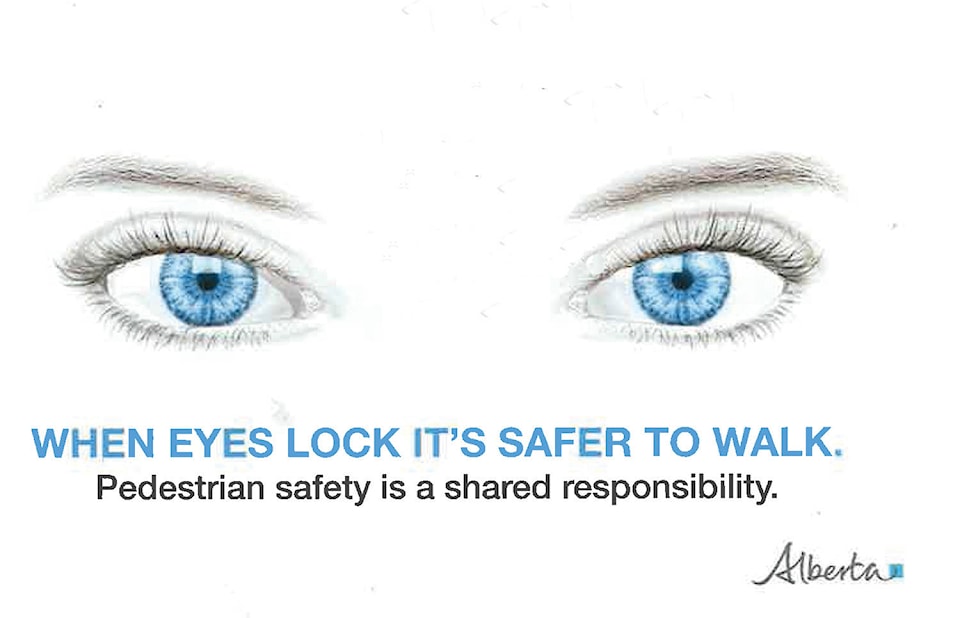The Government of Alberta Ministry of Transportation Office of Traffic Safety is hoping its work regarding driving safety perception will prove to be the catalyst needed to shrift driver and pedestrian behavior in Alberta.
Donna Tona, team lead with the Office of Traffic Safety, presented an overview of the office’s contracted seven-year project to Millet town council during its Jan. 24 meeting.
Between 2012 and 2016 the population of Alberta rose 9.8 per cent, the number of drivers increased 8. 9 per cent, registered vehicles rose by 7.7 per cent, and highway traffic volumes increased 8. 4 per cent.
Tona says in 2015 the social costs of collisions were between an estimated $4.6 billion and $10.3 billion.
“It’s quite busy. The other issue is with more drivers there’s more collisions,” said Tona.
She added Office of Traffic Safety findings reveal most crashes take place on dry surfaces, and the majority involved a van or pickup truck.
Tona says Alberta suffers a bad texting and driving problem. “Texting and driving, we need to make that an addiction issue.”
The Office of Traffic Safety does not subscribe to the idea that serious injury and fatalities on Alberta’s roads are inevitable and acceptable; with education programs the office is working to bring those numbers down.
Vision Zero is a program that comes from Europe. Tona says while the province has not formally adopted Vision Zero it is a program the Office of Traffic Safety is prescribing. “The number of fatalities in Europe have gone down exponentially because of Vision Zero.”
Vision Zero follows a safesystem approach that highlights four subcategories: safe vehicles, safe speed, safe infrastructure and safe road users.
Under the safe road users approach, Vision Zero looks to deter drivers from operating vehicles when they may not be in a safe state to do so. Tona says the program wants to educate drivers to stay away from driving as a means to calm down if they are upset or angry. “Think about emotional safety, think about psychological safety.”
Safe vehicles takes aim at older vehicles that may not be road or driver safe, as well as ensuring large truck and trailer units are loaded safely.
The safe speeds program focuses on driving at safe speeds and driving at speeds safe for whatever road the vehicle is on, “A lot of our roads are older roads,” said Tona.
Under safe infrastructure, Tona says the Office of Traffic Safety will work with other entities to determine where it is safest for infrastructure such as power poles and farmers’ fences to be located, in proximity to the road and ditch.
But the Office of Traffic Safety does not plan on changing the attitudes of Albertan drivers alone, they encourage municipalities to engage their residents in traffic safety programs.
The Alberta Traffic Safety Fund offers grants ranging from $1,000 to $17,000. Tona says this will give municipalities the chance to get creative and innovative in designing a plan that is tailored to each individual community.
The Office of Traffic Safety will be releasing a series of creative artworks for municipalities to use in public awareness campaigns as they see fit.
Coun. Robin Brooks questioned if the Alberta Traffic Safety Fund grant would cover billboard costs with traffic safety messages for Millet such as, “We have two cemeteries and no hospital.”
Mayor Tony Wadsworth mentioned he has concerns with intersections in town that involve left turn/straight lanes and right turn only lanes and wondered if this was something the Office of Traffic Safety could address under its seven-year contracted project.
Tona says one possible route could be to launch a public education campaign to address the challenges that come with such intersections.
